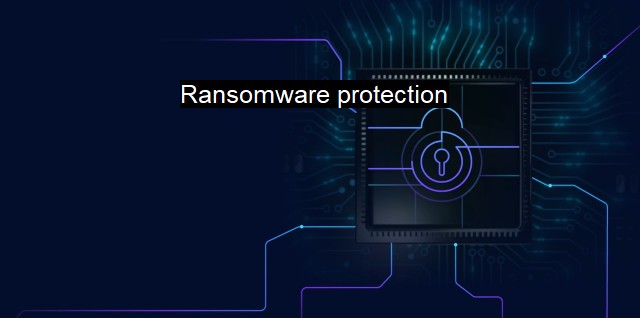What is Ransomware protection?
Why Ransomware Protection is Crucial in Today's Cybersecurity Landscape: Understanding Ransomware, Its Impact, and Effective Solutions
Ransomware protection is a cybersecurity provision that focuses on safeguarding devices, networks, and cloud services from ransomware attacks. Known for its efficacy as a cyber weapon, ransomware usually entails a malicious software that infiltrates your computer system, encrypting your data, and effectively holding your information hostage until a ransom has been paid.To understand the significance of ransomware protection, it's critical to comprehend how ransomware operates. After sneaking into the computer or network system, using various techniques like Trojan disguises or spam email attacks, the ransomware encrypts user's files and data. The victim typically receives a message from the attacker demanding for a 'ransom' to be paid, often in a cryptocurrency like Bitcoin, which provides a level of anonymity to the attacker. Even after paying, there is no guarantee that the data will be decrypted or returned.
Ransomware protection, in this context, plays a preventative role in ensuring that such attacks do not occur on a specific system or device. Traditional antivirus software usually tries to deal with ransomware attacks once they have already infiltrated the system. In contrast, ransomware protection applications aim to proactively detect and block such assaults before they can damage the user's data.
Ransomware protection provides a multi-tier defense against cyber threats. At the forefront, it utilizes comprehensive detection techniques to monitor and safeguard your system from malware attacks. Should any suspicious activity be detected, it accurately identifies the progresses of various malware, particularly different types of ransomware, helping prevent its infiltration.
Secondly, ransomware protection employs isolation techniques. These techniques attempt to isolate the malicious software within one part of the system to limit its spread and potential damage. Containment provisions allow the IT administrators to understand the malware, delimit its extent, while working on eradication procedures without interrupting the overall system functionality.
Another key benefit of ransomware protection is the frequent system backup and recovery function it provides. This process regularly stores information on multiple platforms to ensure that data can be easily restored if an attack occurs. When an attacked file is adequately backed up, the original version can be retrieved, making the attacker's demand pointless.
Further, ransomware protection offers user-behavior training and awareness. Since human error mainly causes most ransomware attacks, it's essential to keep the user informed about the nature of these attacks and how they may present themselves. Therefore, ransomware protection frequently includes awareness sessions and simulations so that the criticality of security threats and the necessary precautions become ingrained within the user mindset.
On a broader level, ransomware protection helps enterprises to maintain their reputation. If a company falls victim to a ransomware attack, not only does it stands to lose financial assets but it also risks tainting its reputation, leading to potential customers' loss and diminishing overall trust. As such, investing in robust ransomware protection ensures business continuity, guarantying trust and confidence in the company's ability to protect customers' data.
Ransomware protection is an indispensable tool in the realm of cybersecurity. It works proactively, identifying potential threats and blocking attempted attacks, effectively safeguarding critical data and systems. Through isolation techniques, it contains attacks, limiting damage and enabling quick action. By continuously backing up data, it nullifies the threat of ransom demands, while user-behavior training aids in evasion of future risks. It is a holistic solution providing an all-round defense against cyber threats, particularly ransomware attacks, ensuring that users can safely interact within the digital realm.

Ransomware protection FAQs
What is ransomware protection?
Ransomware protection is a set of measures that are put in place to safeguard computer systems and networks from ransomware attacks. These measures can include the use of antivirus software, employee training, and backup and recovery solutions.How can antivirus software protect against ransomware attacks?
Antivirus software can help protect against ransomware attacks by detecting and blocking malicious software before it can infect your computer. Many antivirus programs use advanced heuristics and behavioral analysis to identify suspicious activity and stop it before any damage is done.What are some best practices for defending against ransomware attacks?
Some best practices for defending against ransomware attacks include keeping all software up to date, using strong password policies, implementing employee training and awareness programs, and regularly backing up data. Additionally, it is important to implement a robust incident response plan in case an attack does occur.In the event of a ransomware attack, what steps should be taken to recover data?
If you experience a ransomware attack, it is important to immediately isolate the infected device or network segment to prevent further spread. From there, you can attempt to restore data from backup files, or work with a specialist to attempt to decrypt your files. In some cases, it may be necessary to pay the ransom to retrieve your data, but this should be considered a last resort.| | A | | | B | | | C | | | D | | | E | | | F | | | G | | | H | | | I | | | J | | | K | | | L | | | M | |
| | N | | | O | | | P | | | Q | | | R | | | S | | | T | | | U | | | V | | | W | | | X | | | Y | | | Z | |
| | 1 | | | 2 | | | 3 | | | 4 | | | 7 | | | 8 | | |||||||